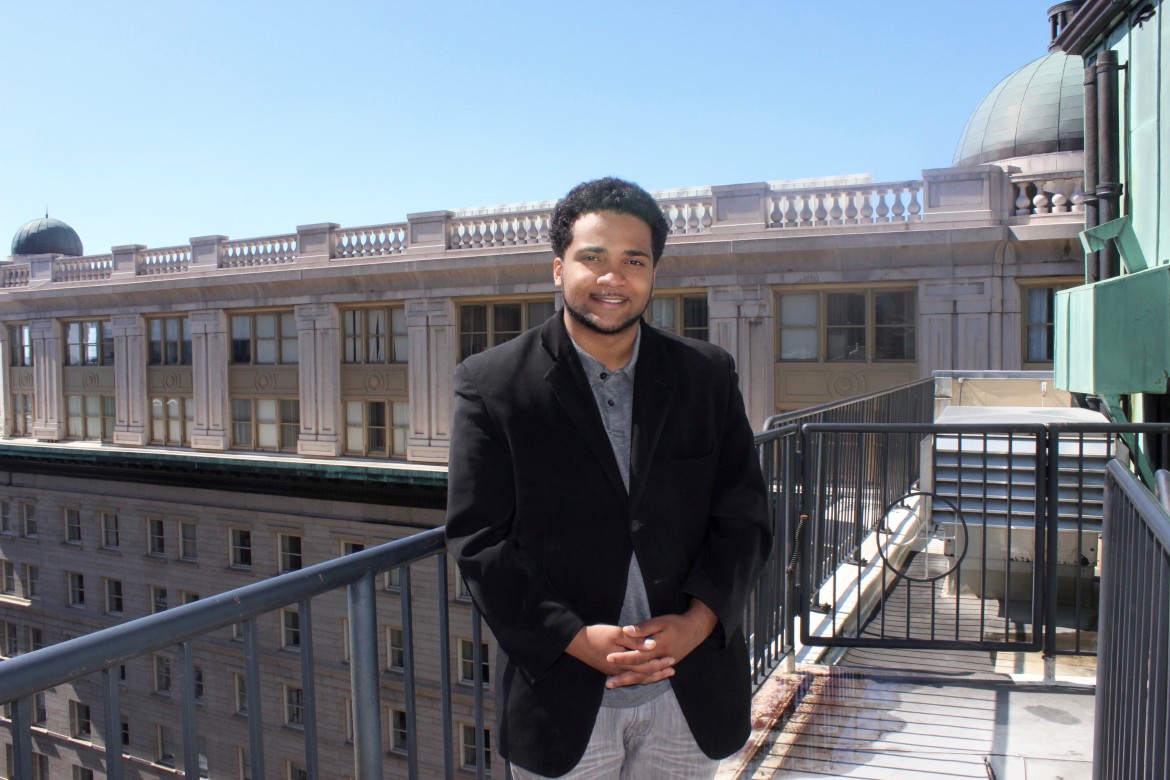
Photo and videos by Sarah Barr
DeAngelo Cortijo, youth representative for the National Center for Youth Law, has experienced both the child welfare and juvenile justice systems.
BOSTON — DeAngelo Cortijo remembers the fear he felt as a young boy on the day his mother was lifted unconscious into an ambulance. He thought he would never see her again.
 It was a moment that set off a yearslong struggle as he bounced between family and foster placements and eventually into the juvenile justice system. Along the way, he grew frustrated by the inability of the child welfare and juvenile justice systems to help him cope with the trauma he had experienced.
It was a moment that set off a yearslong struggle as he bounced between family and foster placements and eventually into the juvenile justice system. Along the way, he grew frustrated by the inability of the child welfare and juvenile justice systems to help him cope with the trauma he had experienced.
“I became angry, confused and gave up,” Cortijo said during the inaugural Dual Status Youth Symposium hosted last week by the RFK National Resource Center for Juvenile Justice.
Cortijo’s plight was a familiar one for the nearly 300 people in the symposium audience who gathered to discuss what’s working and what’s not for dual status youth.
Attendees sought ways to understand trauma, build better data collection and sharing systems, and create work cultures that encourage cooperation.
Cortijo wishes there had been a bridge between the two systems, one that allowed both sides to collectively understand him. He said information about abuse, mental health conditions and treatment plans should be shared to best help youth.
“The purpose is to ensure youth have consistent access to treatment and will reduce chances of being retraumatized — not to be used against the youth but to ensure the youth has the best opportunity at life,” he said.
The conference took place as those in the field are increasingly aware of the potential to improve outcomes for kids through collaboration between child welfare and juvenile justice systems.
Nationally, the resource center has found that in jurisdictions where its experts are working, approximately two-thirds of the juvenile justice population has had some contact with the child welfare system.
John Tuell, executive director of the resource center, said there’s still a long way to go to improve systems, especially when it comes to sharing data. But he’s cheered by how many people attended the conference, and their enthusiasm for making systems work better for youth.
[Related: Assessments May Help Prevent Youth in Child Welfare from Involvement in Juvenile Justice]
“We really just need to grow this force of professionals that have the knowledge, the skills, the leadership to bring about the kinds of reforms that end up resulting in desired outcomes for youth,” he said.
Culture change
Officials who have created dual status programs said it’s critical for child welfare and juvenile justice officials to feel a shared sense of risk and responsibility as they navigate new programs.
“If something bad happens, we’re standing together. When good things are happening like they are now, we’re standing together,” said Laura Garnette, chief probation officer in Santa Clara County, California.
Melissa Blom, manager of the Children, Youth and Family division of the Outagamie County Department of Health and Human Services in Wisconsin, said that cementing a partnership involves a wholesale change in culture, not just new policies.
“You can put a lot of strategies into place in your organization, but if you don’t address the culture, culture eats strategy every time,” she said.
Managers must be role models who show how to have tough conversations across agencies, she added.
A role for judges
Judges who have been involved in dual status reforms said their group also has an important role to play.
Geoffrey Gaither, magistrate in the juvenile division of the Marion County Superior Court in Indiana, said judges may not always be the experts when it comes to dual status youth and should listen carefully to representatives from each agency.
Judges also should be cognizant of the atmosphere they’re setting in the courtroom, which will set the tone for reforms, too, said Willie J. Lovett Jr., judge in the Fulton County Juvenile Court in Atlanta.
“If you’re the judge who jumps down people’s throats for mistakes, if you’re berating people and berating parents and those kinds of things, you create a brand. And then when you try to do an initiative, that brand follows you,” he said.
Blom said judges also should be a part of trainings, so they understand the research on adolescent brain science that’s driving reform. Judges should treat caseworkers and other agency representatives fairly and respectfully, while also holding them accountable, she said.
“Their decisions have a huge impact on not only families but on my staff. Treating staff with dignity is huge,” she said.
Douglas F. Johnson, a judge in Douglas County Juvenile Court in Nebraska, said judges should find ways to interact with child welfare and probation officials both on and off the bench, so that everyone understands how decisions are being made.
“It’s good not to go it alone,” he said.
More related articles:
‘Dual-Status’ Kids Endure Another Kind of Double Jeopardy

Pingback: Jury Convicts Oakland Activist Again Of 2nd Degree Murder For 2016 Shooting | Alameda Bot